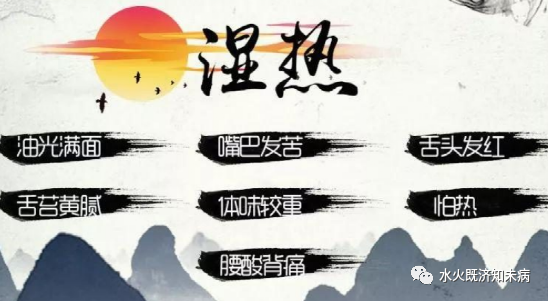
The Damp-Heat syndrome, while having external pathogenic factors, fundamentally arises from insufficient Earth virtue, leading to Spleen deficiency which generates dampness. This dampness obstructs the Qi mechanism and transforms into heat, ultimately resulting in the intermingling of dampness and heat. The pathogenesis is due to the Spleen’s role in the transportation and transformation of water and dampness; when Spleen Qi is deficient, it fails to perform its function, resulting in dampness. Dampness is a tangible evil, belonging to Yin and cold; it obstructs the Qi mechanism, and when Qi is excessive, it transforms into heat. Heat is also a tangible evil, belonging to Yang and heat. The Spleen is fundamentally deficient, while damp-heat is a manifestation of excess, thus creating a complex interplay of deficiency, excess, Yin, Yang, cold, and heat, which can present differently in various locations, making it a challenging syndrome to treat. A slight misstep can easily lead to misdiagnosis or mistreatment. Therefore, Ye Tianshi stated: “Damp-heat is difficult to deal with, and the illness is not easily resolved.” The diagnosis and treatment of damp-heat should pay attention to the following points:1. The pathogenesis of damp-heat involves the intermingling of deficiency, excess, cold, heat, and dampness, which are not equal in clinical practice. One should first note the predominance of dampness or heat and the different evolutions based on the patient’s age, constitution, and medication. Clinical observation of pulse and symptoms should guide treatment of damp-heat syndrome.2. The basic principle for treating damp-heat syndrome is to clear heat and eliminate dampness, distinguishing whether heat is predominant over dampness or vice versa based on the different stages of the illness. Dampness is a Yin pathogen, and the pathogenesis of dampness and heat is fundamentally different, so medication must be appropriate. To clear heat, bitter and cold herbs should be used; excessive use can lead to the transformation of heat into cold, harming Spleen Qi and worsening the condition. Clinically, it is common to see mistakes due to the overuse of heat-clearing herbs. To eliminate dampness, one should warm Yang and promote dampness elimination, supplemented with aromatic and light diuretics, but care must be taken not to overuse warming herbs, which could exacerbate heat and worsen the illness.3. The treatment of damp-heat syndrome, particularly when heat is predominant over dampness, can be traced back to Zhang Zhongjing. For treating jaundice with heat predominating over dampness, Yin Chen Hao Decoction is used. The formula includes Yin Chen (Artemisia capillaris), Zhi Zi (Gardenia), and Da Huang (Rhubarb), all of which are bitter and cold herbs, as bitterness can dry dampness and cold can clear heat. When dampness predominates over heat, Yin Chen Wu Ling San is modified; although Yin Chen is still used to clear heat and reduce jaundice, Zhi Zi and Da Huang are removed, and Bai Zhu (Atractylodes macrocephala) and Gui Zhi (Cinnamon twig) are added, along with Zhu Ling (Polyporus) and Ze Xie (Alisma) to eliminate dampness and reduce jaundice, preventing excessive heat-clearing from harming the Spleen and turning into Yin jaundice. The famous Qing Dynasty physician Cheng Guopeng used Yin Chen Shu Fu Decoction to treat Yin jaundice, also using Yin Chen for jaundice, but found that the warmth of Bai Zhu and Gui Zhi was insufficient to transform cold dampness, thus adding Fu Zi (Aconite) and Gan Jiang (Dried ginger) to warm Yang and transform dampness, demonstrating his insight and achieving excellent results.Additionally, Zhang Zhongjing emphasized the importance of selecting herbs based on different accompanying symptoms when treating jaundice with heat predominating over dampness. For heat with constipation, Yin Chen Hao Decoction is used to promote bowel movements and clear heat; for irritability, Zhi Zi Da Huang Decoction is used, adding Zhi Shi (Bitter orange) and Dou Chi (Fermented soybeans) to regulate Qi and relieve irritability; if heat leads to constipation, Da Huang Nao Shi Decoction is used, adding Mang Xiao (Glauber’s salt) to Da Huang to purge heat accumulation; if there are initial symptoms of exterior syndrome with chills and fever, Ma Huang Lian Qiao Chi Xiao Dou Decoction is used. This illustrates Zhang Zhongjing’s skill in selecting herbs based on symptoms. Clinically, in addition to bowel conditions, attention should also be paid to the amount of sweating, presence of fever, complexion, and appetite, as well as careful examination of tongue coating, tongue quality, and pulse.When treating general damp-heat syndrome, special emphasis is placed on the location of the damp-heat syndrome and the meridian affinities of bitter and cold heat-clearing herbs. For damp-heat in the upper jiao (lung), Huang Qin (Scutellaria) is often used; in the middle jiao (stomach), Huang Lian (Coptis) and Huang Qin are used; in the lower jiao (kidney and bladder), Huang Bai (Phellodendron) is used; and in the liver and gallbladder, Zhi Zi, Yin Chen, and Long Dan Cao (Gentiana) are used.4. When treating damp-heat syndrome with heat predominating over dampness, it is preferred to add herbs that regulate Qi without being overly drying, such as Yu Jin (Curcuma), Zhi Ke (Bitter orange), and Wu Yao (Lindera), as Qi movement promotes dampness elimination, enhancing the effect of dampness elimination while ensuring that dampness is expelled and heat has no place to reside. Furthermore, clearing heat and eliminating dampness should also emphasize the use of herbs that strengthen the Spleen and stomach, as a healthy Spleen and stomach fundamentally eliminate damp-heat and prevent recurrence, while also preventing dampness from injuring Yang Qi and leading to Spleen and stomach sinking syndrome. In the later stages of damp-heat disease, as heat gradually clears but dampness cannot be quickly resolved, and Spleen Qi has not yet recovered, it often manifests as lingering evil and Spleen deficiency, making old illnesses prone to recurrence. At this time, it is still necessary to continue taking herbs to strengthen the Spleen and benefit Qi to consolidate the therapeutic effect. Diet should also be light and easily digestible, avoiding excessive eating or consumption of raw, cold, or rich foods that could burden the Spleen and stomach or harm them, leading to recurrence.5. A typical caseLi XX, male, aged 62. He has long suffered from diabetes, hypertension, and chronic hepatitis. He has developed ascites and was diagnosed with liver cirrhosis with ascites. After using various Western medications without improvement and worsening condition, he presented with full-body jaundice, transitioning from drowsiness to coma, having not defecated for 12 days and not urinated for nearly 2 days, and was given a critical illness notice. At this moment, he was in deep coma, with significant jaundice, a greenish-yellow complexion, relying on intravenous fluids to sustain life, with a red tongue, swollen tongue body, yellow greasy coating, and slippery rapid pulse.Diagnosis: Distention, jaundice, coma.The treatment should urgently use methods to purge heat accumulation and regulate Qi to invigorate blood. Modified Tao Ren Cheng Qi Decoction: Tao Ren (Peach kernel) 10g, Sheng Da Huang (Raw rhubarb) 10g, Zhi Shi 10g, Hou Po (Magnolia bark) 10g, Yin Chen 15g, Mang Xiao 10g (to be decocted in the evening). One dose, administered via nasal feeding. It was instructed that if bowel movements occur about 3 hours after taking the medicine, the patient’s consciousness would gradually clear, and then a re-evaluation and adjustment of medication would be made.Second diagnosis: After taking the above medicine for 3 hours, bowel movements were achieved. That evening, two decoctions were administered via nasal feeding, and the next day the patient regained consciousness but still could not eat. The tongue was red, the tongue body was swollen, the tongue coating was greasy and slightly yellow, and the pulse was wiry and slippery. The treatment was to strengthen the Spleen, promote water metabolism, and soothe the liver and benefit the gallbladder.Using modified Yin Chen Si Ling San: Tu Chao Bai Zhu (Atractylodes) 10g, Fu Ling (Poria) 20g, Zhu Ling 10g, Ze Xie 15g, Yin Chen 12g, Chao Xiang Fu (Cyperus) 10g, vinegar-fried Yu Jin 10g, Chai Hu (Bupleurum) 6g, corn silk 20g, Bai Dou Kou (Cardamom) 10g, Tao Ren 10g, Gan Cao (Licorice) 3g, for 7 doses, decocted for oral administration.Third diagnosis: After taking the above medicine, ascites and jaundice significantly reduced, bowel movements normalized, and the patient was able to eat, gradually increasing intake, with improved spirit, a pale red tongue, slightly swollen tongue body, white greasy coating, and wiry slippery pulse. The heat signs significantly reduced, and the previous formula remained unchanged, adding Gui Zhi 6g to promote Yang and benefit water metabolism, assisting the bladder’s Qi transformation, for 14 doses, decocted for oral administration.Fourth diagnosis: Ascites and jaundice disappeared, diet was acceptable, spirit improved, and the patient could get out of bed for light activities, with a pale red tongue, thin white coating, and thin wiry pulse. The treatment was to soothe the liver, strengthen the Spleen, regulate Qi, and invigorate blood to address both the root and branch.Medicinal ingredients: Dang Gui (Angelica) 10g, Chao Bai Shao (White peony) 12g, Tu Chao Bai Zhu 10g, Fu Ling 15g, Chai Hu 6g, Chao Xiang Fu 10g, Sha Ren (Amomum) 8g, vinegar-fried Yu Jin 10g, Bie Jia (Tortoise shell) 15g, Qing Pi (Green tangerine peel) 10g, Chao Yi Yi Ren (Job’s tears) 20g, Tai Zi Shen (Pseudostellaria) 15g, Hou Po 10g, Gan Cao 3g. This formula was taken continuously for over a month, with good diet and spirit, and the distention was basically cured, allowing for discharge and recuperation. Five years later, follow-up showed that the distention had not recurred.Damp-heat syndrome leading to coma is a difficult and serious condition. The intermingling of dampness and heat causing coma should be treated urgently with bitter and cold Da Huang and Mang Xiao to purge heat accumulation, while generally being cautious with their use. After resolving the heat accumulation, medication should be adjusted based on the changes in pathogenesis. After resolving critical symptoms, the focus should be on soothing the liver and strengthening the Spleen, particularly emphasizing Spleen strengthening. Strengthening the Spleen and eliminating dampness should be done with warming herbs, avoiding bitter and cold herbs that harm the Spleen, while also not limiting oneself to a single formula and losing the principle of differential diagnosis and treatment.This is a platform for sharing TCM knowledge; a place for differentiation and discussion. Friends who love TCM, please follow and share!!! 

